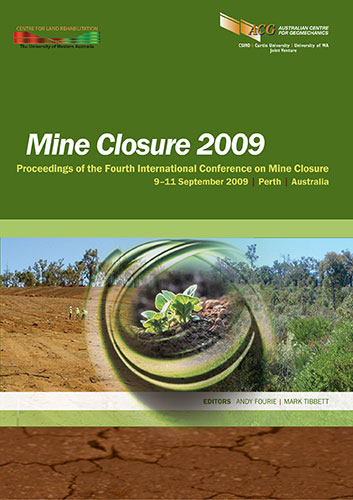New regulatory approaches in rehabilitation cost estimation — how successful have they been?

|
Authors: Woolley, M; Hutton, A |
DOI https://doi.org/10.36487/ACG_repo/908_12
Cite As:
Woolley, M & Hutton, A 2009, 'New regulatory approaches in rehabilitation cost estimation — how successful have they been?', in AB Fourie & M Tibbett (eds), Mine Closure 2009: Proceedings of the Fourth International Conference on Mine Closure, Australian Centre for Geomechanics, Perth, pp. 275-186, https://doi.org/10.36487/ACG_repo/908_12
Abstract:
The global financial crisis and related reductions in commodity prices have had a significant impact on the mining industry, and as a result more mines may be forced into premature closure. Inevitably some of these are likely to join lists of derelict mines across the nation. For state governments across Australia, the need has arguably never been greater to ensure security bonds at mine sites are accurate and that the related liabilities are adequately covered by the security bonds that are held. Strategies to limit future government liabilities have been developed by some governments such as New South Wales (NSW) and Victoria who have recently developed and implemented new approaches to closure cost estimation to assist in establishing more accurate security bonds. Following an independent assessment of the security review process, including benchmarking of processes against other agencies in Australia and worldwide, the NSW Department of Primary Industries – Mineral Resources (DPI–MR) implemented a recommendation that mine operators have the responsibility for self-assessment of the total costs required for rehabilitation and closure. A rehabilitation cost estimate tool (referred to in this paper as the rehabilitation calculator) was developed to provide a consistent approach for all NSW mine sites to be used in their estimation of closure liabilities. The costs would then form a guide for the NSW DPI–MR to use in security bond calculation. The rehabilitation calculator has been used as a basis for closure cost assessment in NSW since 2005 with some minor amendments. It has since been reviewed, improved and adapted for use by the Victorian DPI in their management of mines and extractive industries. This paper explores the improvements and refinements made to the rehabilitation calculator, and suggests further improvements that can be made. It also includes discussion on the outcomes of the use of the rehabilitation calculators in both NSW and Victoria over the last two to four years, with commentary from perspectives of both government and industry stakeholders being considered. The paper concludes with a discussion on the possible benefits of a national approach to closure cost estimation, with particular reference to a consistent approach for those companies that operate across state borders.
References:
Minerals Council of Australia (MCA) (2008) Submission on the Draft Guideline: Establishment and Management of
Rehabilitation Bonds for the Mining and Extractive Industries, Minerals Council of Australia – Victorian
Division, 3 July 2008.
Woolley, M. (2004) Options Assessment Paper, Review of Security Bond Estimation Processes, URS Australia report,
Sydney, (unpublished).
Woolley, M. (2002) Review of Mine Rehabilitation Security Processes, URS Australia report, Sydney, (unpublished).
Woolley, M. and Hutton, A. (2007) A New Approach in Calculating Mine Security Bonds, Course No. 0705: Planning
for Mine Closure Seminar, 14–15 June 2007, Perth, Australia, Australian Centre for Geomechanics, Perth,
Sec. 1, 4 p.
Woolley, M. and Hutton, A. (2006) Calculating a Realistic Security Bond and Assessing True Mine Closure Liabilities,
In Proceedings of the First International Seminar on Mine Closure, Mine Closure 2006, A.B. Fourie, M. Tibbett
(eds), 13–15 September 2006, Perth, Australia, Australian Centre for Geomechanics, Perth, pp. 525–536.
© Copyright 2025, Australian Centre for Geomechanics (ACG), The University of Western Australia. All rights reserved.
View copyright/legal information
Please direct any queries or error reports to repository-acg@uwa.edu.au
View copyright/legal information
Please direct any queries or error reports to repository-acg@uwa.edu.au